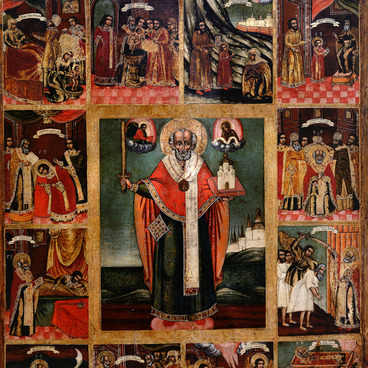The Eastern Orthodox considers Michael the Chief Commander of the heavenly host of angels and archangels. This image can be often seen in Christian art. The icon from the collection of Novosibirsk State Art Museum features apocalyptic imagery: the horseman is riding a winged horse. The defeated devil is under its hooves. This plot was first used in Russian art in the 16th century and quickly rose to high popularity, particularly in the community of Old Believers, where this very icon was created.
The icon was painted in the Ural region, one of the focal points of the Old Believers community. In the 17th century, the followers of this religious movement were forced to relocate to remote areas in the wake of Patriarch Nikon’s reforms and subsequent persecution. With time, the region saw the development of a unique icon-painting style. It was called the NevyAnsk school.
Icon painters of the Nevyansk school were guided by the old Russian traditions and medieval interpretation of Christian images. Masters of the Nevyansk school also avoided excessive ornateness and stuck to strict rules when painting. Among other things, they never lent individual features to the faces of saints because Old Believers cherished the notions of community and sobornost, an idea of spiritual unity. At the same time, the tradition was clearly influenced by baroque and classicism.
The Nevyansk icon has retained its unique imagery and spirituality, festiveness, and vividness. These features were also inherent in Old Russian painting.
Among Old Believers, the image of Archangel Michael was widely revered. The Scripture often refers to Michael as the “chief prince” and “leader of the heavenly hosts.” Michael is portrayed as the key champion opposing the devil and all kinds of lawlessness occurring among people. This is how he appears in the icon from the museum collection. On a gold background, there is a rapid, fearsome, red-faced rider. He is clad in a scarlet flying cloak and shining armor. His whole image is filled with sublimity.
The icon was painted in the Ural region, one of the focal points of the Old Believers community. In the 17th century, the followers of this religious movement were forced to relocate to remote areas in the wake of Patriarch Nikon’s reforms and subsequent persecution. With time, the region saw the development of a unique icon-painting style. It was called the NevyAnsk school.
Icon painters of the Nevyansk school were guided by the old Russian traditions and medieval interpretation of Christian images. Masters of the Nevyansk school also avoided excessive ornateness and stuck to strict rules when painting. Among other things, they never lent individual features to the faces of saints because Old Believers cherished the notions of community and sobornost, an idea of spiritual unity. At the same time, the tradition was clearly influenced by baroque and classicism.
The Nevyansk icon has retained its unique imagery and spirituality, festiveness, and vividness. These features were also inherent in Old Russian painting.
Among Old Believers, the image of Archangel Michael was widely revered. The Scripture often refers to Michael as the “chief prince” and “leader of the heavenly hosts.” Michael is portrayed as the key champion opposing the devil and all kinds of lawlessness occurring among people. This is how he appears in the icon from the museum collection. On a gold background, there is a rapid, fearsome, red-faced rider. He is clad in a scarlet flying cloak and shining armor. His whole image is filled with sublimity.
